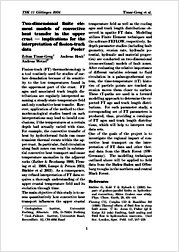Two-dimensional finite element models of convective heat transfer in the upper crust — implications for the interpretation of fission-track data
Timar-Geng, Zoltan
Henk, Andreas
Wetzel, Andreas
Universitätsverlag Göttingen
Sammelband- / Konferenzbeitrag
Verlagsversion
Deutsch
Timar-Geng, Zoltan; Henk, Andreas; Wetzel, Andreas, 2006: Two-dimensional finite element models of convective heat transfer in the upper crust — implications for the interpretation of fission-track data. In: Philipp, S.; Leiss, B; Vollbrecht, A.; Tanner, D.; Gudmundsson, A. (eds.): 11. Symposium "Tektonik, Struktur- und Kristallingeologie"; 2006, Univ.-Verl. Göttingen, p. 228 - 229., , DOI: 10.23689/fidgeo-1907.
 |
Dokument öffnen: |
Fission-track (FT) thermochronology is
a tool routinely used for studies of surface
denudation because of its sensitivity
to the low temperatures found in
the uppermost part of the crust. FT
ages and associated track length distributions
are regularly interpreted assuming
a steady-state temperature field
and only conductive heat transfer. However,
application of the method to thermochronological
studies based on such
interpretations may lead to invalid conclusions,
if the temperatures at a certain
depth had actually varied with time.
For example, the convective transfer of
heat by hydrothermal fluids can cause
transient thermal events within the upper
crust. In particular, fluid circulation
along fault zones can result in substantial
convective heat transport and cause
temperature anomalies in the adjacent
rocks (Zuther & Brockamp 1988, Fleming
et al. 1998, Lampe & Person 2002,
Bächler et al 2003). As a consequence,
any refined interpretation of FT data requires
a thorough understanding of the
upper crustal temperature field and its
evolution through time.
The main objective of this study is to assess
quantitatively how convective heat
transport influences the upper crustal temperature field as well as the cooling
ages and track length distributions observed
in apatite FT data...

